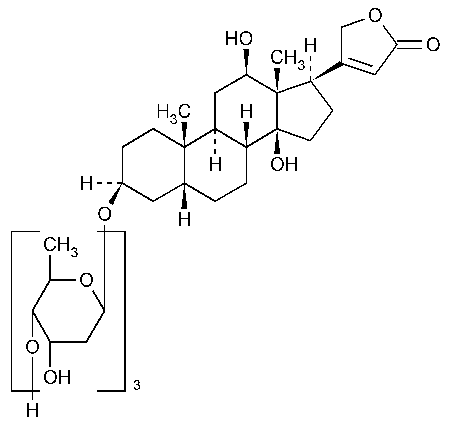Digoxin
C41H64O14
780.94
Card-20(22)-enolide,3-[(O-2,6-dideoxy-b-D-ribo-hexopyranosyl-(1®4)-O-2,6-dideoxy-b-D-ribo-hexopyranosyl-(1®4)-2,6-dideoxy-b-D-ribo-hexopyranosyl)oxy]-12,14-dihydroxy-,(3b,5b,12b)-.
Digoxin.
3b-[(O-2,6-Dideoxy-b-D-ribo-hexopyranosyl-(1®4)-O-2,6-dideoxy-b-D-ribo-hexopyranosyl-(1®4)-2,6-dideoxy-b-D-ribo-hexopyranosyl)oxy]-12b,14-dihydroxy-5b-card-20(22)-enolide [20830-75-5].
Card-20(22)-enolide,3-[(O-2,6-dideoxy-b-D-ribo-hexopyranosyl-(1®4)-O-2,6-dideoxy-b-D-ribo-hexopyranosyl-(1®4)-2,6-dideoxy-b-D-ribo-hexopyranosyl)oxy]-12,14-dihydroxy-,(3b,5b,12b)-.
Digoxin.
3b-[(O-2,6-Dideoxy-b-D-ribo-hexopyranosyl-(1®4)-O-2,6-dideoxy-b-D-ribo-hexopyranosyl-(1®4)-2,6-dideoxy-b-D-ribo-hexopyranosyl)oxy]-12b,14-dihydroxy-5b-card-20(22)-enolide [20830-75-5].
»Digoxin is a cardiotonic glycoside obtained from the leaves of Digitalis lanataEhrhart (Fam.Scrophulariaceae).It contains not less than 95.0percent and not more than 101.0percent of C41H64O14,calculated on the dried basis.
Caution—Handle Digoxin with exceptional care,since it is extremely poisonous.
Packaging and storage—
Preserve in tight containers.
Identification—
A:
Infrared Absorption á197Kñ.
B:
The retention time of the major peak in the chromatogram of the Assay preparationcorresponds to that of the Standard preparationas obtained in the Assay.
C:
Examine in visible light the thin-layer chromatograph prepared as directed in the test for Related glycosides:the RFvalue of the principal blue spot obtained from the Test solutioncorresponds to that obtained from the Standard solution.
Loss on drying á731ñ—
Dry it in vacuum at 105 for 1hour:it loses not more than 1.0%of its weight.
for 1hour:it loses not more than 1.0%of its weight.
Residue on ignition á281ñ:
not more than 0.5%,a 100-mg specimen being used.
Related glycosides—
Chloramine T–trichloroacetic acid reagent—
Mix 10mLof a freshly prepared solution of chloramine T(3in 100)and 40mLof a 1in 4solution of trichloroacetic acid in dehydrated alcohol.
Spotting solvent—
Prepare a mixture of chloroform and methanol (2:1).
Standard solution—
Dissolve an accurately weighed quantity of USP Digoxin RSin Spotting solventto obtain a solution containing 10mg per mL.
Gitoxin standard solution—
Dissolve an accurately weighed quantity of USP Gitoxin RSin Spotting solventto obtain a solution containing 0.30mg per mL.
Test solution—
Transfer 250.0mg of Digoxin to a 25-mLvolumetric flask,dissolve in and dilute with Spotting solventto volume,and mix.
Procedure—
Apply 10µLof the Test solution,10µLof the Standard solution,and 10µLof the Gitoxin standard solutionon a line parallel to and about 2.5cm from the bottom edge of a reversed-phase thin-layer chromatographic plate coated with a 0.25-mm layer of chromatographic silica gel mixture to which is permanently bonded octadecylsilane (C18).Allow the spots to dry,and place the plates in a developing chamber containing a mixture of methanol and water (7:3).Develop the chromatogram until the solvent front has moved about 15cm above the line of application.Remove the plate,and allow the solvent to evaporate.Spray the plate with Chloramine T–trichloroacetic acid reagent,freshly mixed,and heat in an oven at 110 for 10minutes.Examine the plate under long-wavelength UVlight:no spot from the Test solutionexcept that due to digoxin is more intense than the spot from the Gitoxin standard solution(not more than 3%of any related glycoside as gitoxin).
for 10minutes.Examine the plate under long-wavelength UVlight:no spot from the Test solutionexcept that due to digoxin is more intense than the spot from the Gitoxin standard solution(not more than 3%of any related glycoside as gitoxin).
Organic volatile impurities,Method IVá467ñ:
meets the requirements,except the limits for methylene chloride and chloroform are 2000µg per g.
Solvent—
Use dimethyl sulfoxide.
Assay—
Mobile phase—
Prepare a suitable degassed and filtered mixture of water and acetonitrile (37:13),making adjustments if necessary (see System Suitabilityunder Chromatography á621ñ).
Standard preparation—
Dissolve an accurately weighed quantity of USP Digoxin RSin diluted alcohol,and dilute quantitatively and stepwise with diluted alcohol to obtain a solution having a known concentration of about 250µg per mL.Use a sonic bath to aid dissolution.
Assay preparation—
Transfer about 50mg of Digoxin,accurately weighed,to a 200-mLvolumetric flask.Dissolve in about 150mLof diluted alcohol by sonication,dilute with diluted alcohol to volume,and mix.
System suitability preparation—
Prepare a solution in diluted alcohol of USP Digoxin RSand digoxigenin having concentrations of about 40µg of each per mL.
Chromatographic system (see Chromatography á621ñ)—
The liquid chromatograph is equipped with a 218-nm detector and a 4.2-mm ×25-cm column that contains packing L1and a 3.2-mm ×15-mm guard column that contains packing L1.The flow rate is about 3.0mLper minute.Chromatograph the System suitability preparation,and record the peak responses as directed for Procedure:the resolution,R,between digoxin and digoxigenin is not less than 4.0;the column efficiency determined from the digoxin peak is not less than 1200theoretical plates;the tailing factor for the digoxin peak is not more than 2.0;and the relative standard deviation for replicate injection is not more than 2.0%.
Procedure—
Separately inject equal volumes (about 10µL)of the Standard preparationand the Assay preparationinto the chromatograph,record the chromatograms,and measure the responses for the major peaks.Calculate the quantity,in mg,of C41H64O14in the portion of Digoxin taken by the formula:
0.2C(rU/rS),
in which Cis the concentration,in µg per mL,ofUSP Digoxin RSin the Standard preparation;and rUand rSare the responses for the digoxin peaks obtained from the Assay preparationand the Standard preparation,respectively.
Auxiliary Information—
Staff Liaison:Gabriel I.Giancaspro,Ph.D.,Senior Scientist and Latin American Specialist
Expert Committee:(DSB)Dietary Supplements:Botanicals
USP28–NF23Page 644
Pharmacopeial Forum:Volume No.27(2)Page 2138
Phone Number:1-301-816-8343
